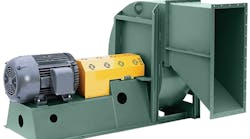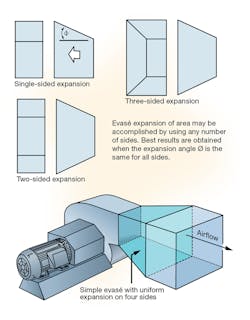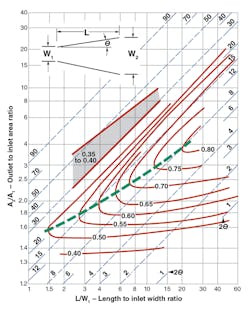Editor’s note: This article is adapted from the Summer 2015 AMCA inmotion article “Evasés: What They Are and How and Why to Use Them,” portions of which were taken from articles written by former Air Movement and Control Association International Director of Engineering Standards Paul Saxon.1,2 To read the full article, go to www.amca.org/resources/inmotion.php.
“Evasé” (pronounced “ey-vah-zey”) is a word of French origin equated to the English word “flare,” as in to expand or open outward. That makes sense, as in the fan industry, an evasé is an appurtenance that, when located directly at a fan outlet, results in a larger outlet area, allowing the regain of static pressure. The evasé, also known as an expanded outlet or diffuser, can be in one of several configurations, as shown in Figure 1.
Why Evasés Are Used
When fan performance is specified as requiring static pressure at the outlet, an evasé can be used to convert high velocity and corresponding velocity pressure to increased static pressure. This process of increasing outlet static pressure is known as static-pressure regain, which is an application of Bernoulli’s principle.
It is important to note that only a portion of velocity pressure is regained as static pressure; the remainder is a total pressure loss in the evasé.
The percentage of velocity pressure regained as static pressure depends on the geometry of the evasé. An evasé can be conical or rectangular in shape. In the case of a rectangular evasé, the number of sides that diverge simultaneously and the angle at which each side diverges are variables to be considered. The ratio of the larger area to the smaller area also is a factor, one with trade-offs. The percent regain is highest for the lowest area ratio and for the smallest divergence angle.
Other benefits of using an evasé include reduced power consumption and lower sound levels. Evasés provide a slightly lower fan speed for belt-drive units and a smaller diameter for direct-drive units.
Evasé Sizing and Selection
Fortunately, there are charts for estimating the effect of an evasé based on the evasé’s geometry. Figure 2 provides coefficients of pressure recovery for plane (nonconical) diffusers. These coefficients are multiplied by the velocity pressure at the inlet to an evasé to determine the static pressure that will be regained. Figure 3 provides effectiveness values for plane (nonconical) diffusers. These effectiveness values are multiplied by the difference in velocity pressure between the inlet and outlet of an evasé to determine the static pressure that will be regained. Similar charts exist for conical diffusers.
Many fans have velocities higher than a system designer would want to run through outlet ductwork, as ducting losses would be high at those velocities. In such cases, expanding the duct area using an evasé does more than just produce static-pressure regain from the fan. It also reduces outlet-duct system losses through the use of larger ductwork.
With some systems, space is constricted, and relatively small ducts with high static-pressure losses must be used. In such cases, the user pays a penalty in the form of high operating costs. If size is not severely constricted, use of larger ductwork and moving air at a lower velocity can be beneficial. As a rule of thumb, when design predicts air velocity in a system will reach or exceed 3,000 fpm, an evasé and larger ductwork should be considered.
Pressure Relationships
Figure 4 is a pressure diagram of a fan with and without an evasé. As can be seen, fan static pressure (Ps) and static-pressure rise (∆Ps) increase and fan total pressure (Pt) decreases with the use of an evasé.
Contrary to popular belief, fan-outlet area does not have to match duct size. However, one should remember air has inertia. When forced to change direction abruptly, air becomes turbulent, resulting in pressure loss. The key is to minimize size differences so transitions are smooth and gradual and airflow is relatively undisturbed.
Essentially a piece of expanding ducting, an evasé can be supplied by either the fan manufacturer or the fan purchaser. When a fan has been selected to employ an evasé for static-pressure regain, fan performance depends on this section of duct being present. When fan performance is based on the use of an evasé, the performance curve supplied by the fan manufacturer normally includes the estimated effect of the evasé, regardless of who supplies the evasé.
There is no universal “evasé solution,” but when static pressure is required at a fan outlet, the use of an evasé can be beneficial.
References
- Saxon, P. (1987). Outlet duct evasé – A free lunch? TechSpecs, III, 1.
- Saxon, P. (1996). The evase – What it is and what it does. TechSpecs, XI, 1.
- Jorgenson, R. (1999). Fan engineering (9th ed.). Buffalo, NY: Howden.
James T. Greenzweig, PE, is technical sales manager for Howden North America. Joe Brooks is director of certification programs for Air Movement and Control Association International.
Did you find this article useful? Send comments and suggestions to Executive Editor Scott Arnold at [email protected].














